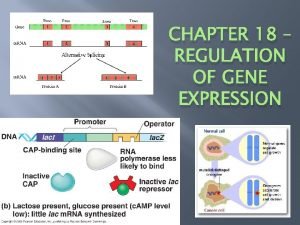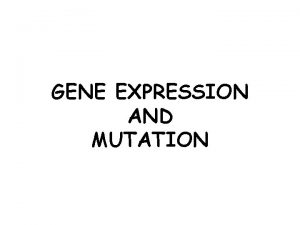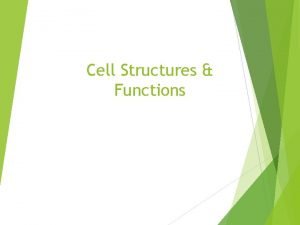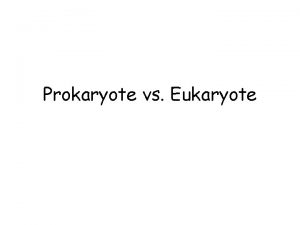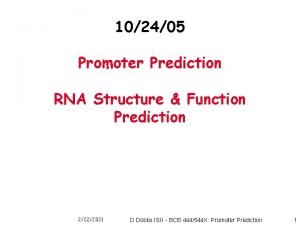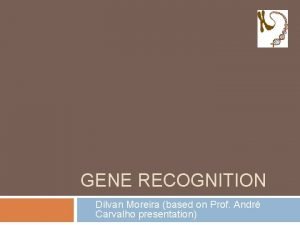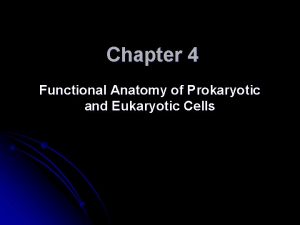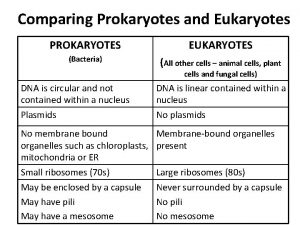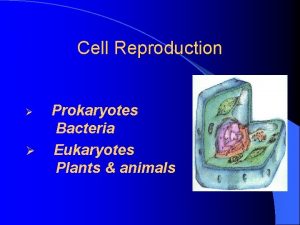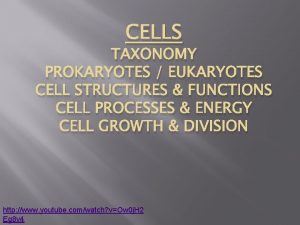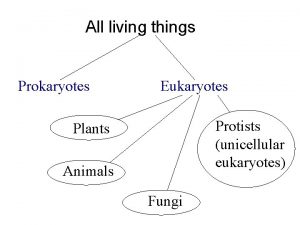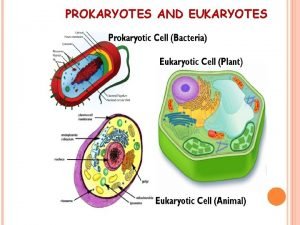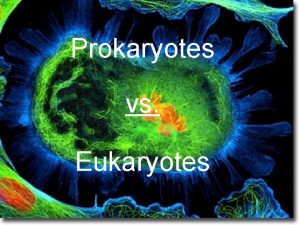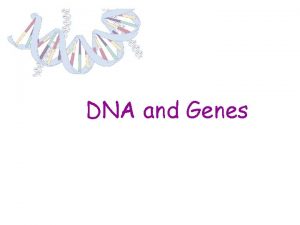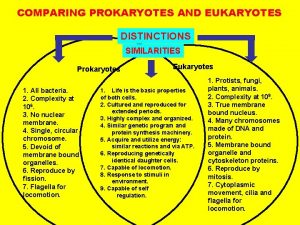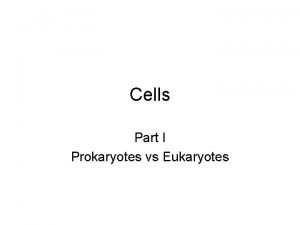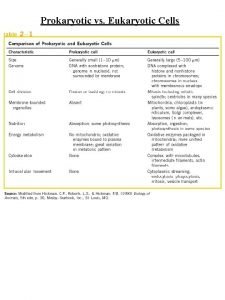Overview of Cells Prokaryotes vs Eukaryotes The Cell















- Slides: 15

Overview of Cells • Prokaryotes vs Eukaryotes • The Cell Organelles • The Endosymbiotic Theory

Prokaryotic Cells • Archaea • Bacteria • Come in many different shapes and sizes ü. 5 µm – 2 µm, up to 60 µm long • Have large surface to volume ration – nutrients from outside can easily reach all parts of the cell

Eukaryotic Cells • • Protists Fungi Animal Cells Plant Cells • Like prokaryotic cells, eukaryotic cells come in many different shapes and sizes, but have the same basic set of organelles • Multicellular organisms (fungi, plants and animals) have specialized eukaryotic cells that each perform a particular job and all work together for the benefit of the organism

Eukaryotic Cells Common Organelles – Plasma membrane – Nucleus ü ü ü Chromatin (DNA) Nucleolus Nuclear Envelope – Ribosomes – Rough Endoplasmic Reticulum (rough ER) – Smooth Endoplasmic Reticulum (smooth ER) – Golgi Apparatus – Centrioles – Mitochondria – Cytoskeleton – Vesicles, Peroxisomes, Lysosomes, Small Vacuoles

Eukaryotic Cells Organelles only found in Plants – All those in animal cells except Centrioles – plus PCell Wall PChloroplasts PLarge Vacuoles – The cell wall and vacuoles help plant cells maintain a rigid shape (keep plant from drooping)

Organelles • Organelles are the parts within a cell that have specific functions • Prokaryotic cells (e. g. bacteria) are smaller and less complex (fewer organelles) than eukaryotic cells. Eukaryotic Cells Prokaryotic Cells Plant Cells – Plasma Membrane (eukaryotic) – Plasma Membrane – Cytoplasm – – Cytoplasm Cell Wall DNA (no nucleus) Ribosomes – Nucleus – – – – ü ü ü Chromatin (DNA) Nucleolus Nuclear Envelope – Cell Wall – Chloroplasts – Vacuole Ribosomes Vesicles, Peroxisomes, Lysosomes Rough Endoplasmic Reticulum Smooth Endoplasmic Reticulum Golgi Apparatus Centrioles Mitochondria Cytoskeleton

Organelles Polysaccharides Organelles are made of: • Proteins – made of amino acids • Lipids – made of fatty acids • Carbohydrates - polysaccharides made of sacharides (sugars) • Nucleic Acids (DNA and RNA) – made of nucleotides Proteins (Polypeptides) Lipids Nucleic Acids

Components found in all cells Plasma Membrane • Made of a Phospholipid Bilayer • Various proteins, lipids, and sugars float in membrane • Semipermeable ü Small hydrophobic molecules pass easily through ü Contains pores that enable water and very small ions to pass through ü large molecules must pass through channel proteins

Components found in all cells Plasma Membrane ü Eukaryotic cells also membrane-bound internal organelles composed of lipid bilayer membranes • Nuclear Envelope • Golgi Apparatus • Endoplasmic Reticulum (rough and smooth) • Mitochondria • Chloroplasts (in plants) • Vesicles, Lysosomes, Peroxisomes & Vacuoles

Components found in all cells Cytoplasm • The fluid that fills cells and surrounds the organelles • Consists of: • Water (mostly) • Proteins (e. g. hormones and enzymes) • Small Molecules (e. g. ions)

Components found in all cells DNA • Prokaryotic Cells • May be linear or circular • Contained in the nuclear region (nucleoid) • May also include short, circular plasmids • Eukaryotic Cells • Longer (approx. 9 feet per cell in humans), coiled around histone proteins to help pack it into the cell • Always linear • Contained in the nucleus • Known as chromatin when relaxed and chromosomes when condensed (supercoiled)

Components found in all cells Ribosomes • Float freely in the cytoplasm of prokaryotic and eukaryotic cells • Also coat the rough ER of eukaryotic cells

Components found in all cells Ribosomes • Build proteins using instructions encoded in DNA

Components found in all cells Ribosomes • Build proteins using instructions encoded in DNA • Complex of protein and r. RNA forming two subunits Purple = Proteins Blue = r. RNA of small subunit Grey = r. RNA of large subunit

Components found only in Eukaryotic Cells Nucleus • Nuclear Envelope ü double membrane ü nuclear pores allow RNA to exit • Chromatin – “relaxed” DNA • Nucleolus – where ribosomes are assembled
 Gene expression in prokaryotes and eukaryotes
Gene expression in prokaryotes and eukaryotes Prokaryotic and eukaryotic venn diagram
Prokaryotic and eukaryotic venn diagram Prokaryotes vs eukaryotes gene regulation
Prokaryotes vs eukaryotes gene regulation Small vacuoles
Small vacuoles Diff between prokaryotes and eukaryotes
Diff between prokaryotes and eukaryotes Cytoskeleton nickname
Cytoskeleton nickname Is protist a prokaryote or eukaryote
Is protist a prokaryote or eukaryote Prokaryote vs eukaryote worksheet
Prokaryote vs eukaryote worksheet Prokaryotes vs eukaryotes
Prokaryotes vs eukaryotes Multiple choice questions on prokaryotes and eukaryotes
Multiple choice questions on prokaryotes and eukaryotes Gene prediction in prokaryotes and eukaryotes
Gene prediction in prokaryotes and eukaryotes Prokaryotic and eukaryotic cells chart
Prokaryotic and eukaryotic cells chart Prokaryotes and eukaryotes
Prokaryotes and eukaryotes Prokaryotic vs eukaryotic cells venn diagram
Prokaryotic vs eukaryotic cells venn diagram Prokaryotic cell wall
Prokaryotic cell wall Anatomy of prokaryotes and eukaryotes
Anatomy of prokaryotes and eukaryotes


